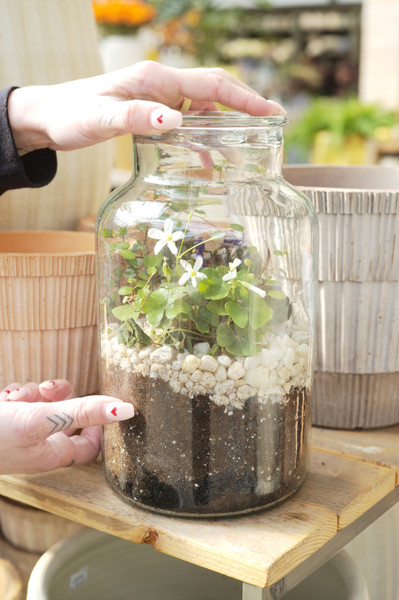How to Build a Terrarium
Posted by Jessie Jacobson on Feb 20th 2025
How to Build a Terrarium
Terrariums are tiny, contained landscapes. The word terrarium is derived from the Latin word terra, meaning earth, and the suffix -arium which denotes a vessel or location. In Latin speak, a terrarium is simply earth in a vessel. Easy to construct and maintain, terrariums can be created in just about any container.
Terrariums can be open or closed systems. Closed terrariums have their own eco system - water vapor is released from the plants and soil, forms as condensation on the top and sides of the container and is deposited back, like rain. These closed environments require little maintenance. Open terrariums are best for plants that like it on the dry side, like cacti and succulents. Make sure that the combination of plants you choose will get along together in the environment you are creating.
Materials List
- A clear glass container, the Fat Bowl Vase is a great option.
- Activated Charcoal
- River Rock or Pearl Stone
- Espoma’s Organic Seed Starting Mix
- Mini Plants
- Decorative rocks, we love the soil toppers from Sol Soils.
- Preserved Moss or Woodland Moss
- Other fun items - crystals, decorative stones, tiny animal figures, terra cotta shards, stones, shells, or other collected items.
Step by Step
- Choose a container you love
- Layer about a half inch of charcoal in the bottom of your vessel This keeps the soil fresh and filters out impurities.
- Add about 1 to 2 inches of small pebbles or rocks. This is for drainage and water percolation.
- Layer potting soil to a depth of 3-4” depending on the size of the plants you have selected.
- Choose plants you love, just make sure they’re little enough to fit in your container. Great options are baby tears, mini ferns, angel vine, and creeping fig.
- Layout your plants as if in a landscape – trees, shrubs, plants, grassy areas. Leave room for a path, dry creek bed, other decorative elements
- Remove plants from container, gently remove any excess soil. Using a small tool of some sort, carefully make a hole in the soil and set in the plant, tapping the soil firmly around the plant to keep it in place.
- Add top dressing such as decorative rocks and sheet moss.
- Gently water or mist plants to water them in.
Terrarium Care
For a closed container
- Place in bright light, but not direct sun. Hot sun will cause the temperature to rise quickly in a closed system – think greenhouse effect.
- Some condensation or tiny droplets of water on the glass is normal and a sign of a healthy eco-system. If the droplets of water are large, open the container to allow for moisture escape.
- Closed terrariums require little watering. Add water when needed, either a little at a time or mist with a spray bottle. If water rests in the bottom layer of rocks, there is too much and some needs to be removed. A turkey baster or syringe may help.
- Use distilled water or tap water that has been left out for at least 24 hours to be sure your water is free of contaminants.
- Remove and replace failing plants. Yes, this is part of the cycle.
- Prune and trim plants occasionally to keep the arrangement neat and tidy.
- Closed terrariums do not need much fertilizer. Use a weak solution (1/4 strength), once a month during active growth to keep plants healthy. In this case, it’s more desirable to keep the plants small - fertilizer will only make them grow larger.
- Be on the look-out for pests and treat as needed.
For an open container
- Care considerations are very much the same in open terrarium systems. However, they may require more attention to watering. Add water in small amounts to be sure not to overwater. A spray bottle is a great way to gently water.
Planting a terrarium is a great winter project and provides a way to connect with the natural world. Get the kids involved or invite your friends over for a planting party, adult beverages included. Take your time, sniff the soil, and enjoy!
Also check out a video from the archives for a visual guide to terrarium construction and design!

